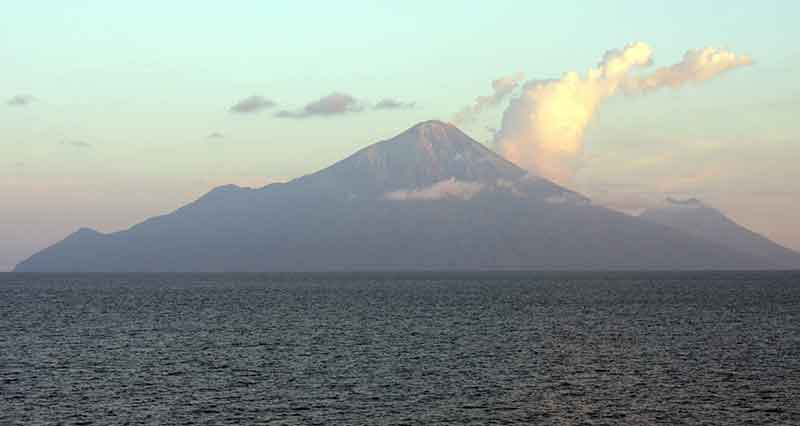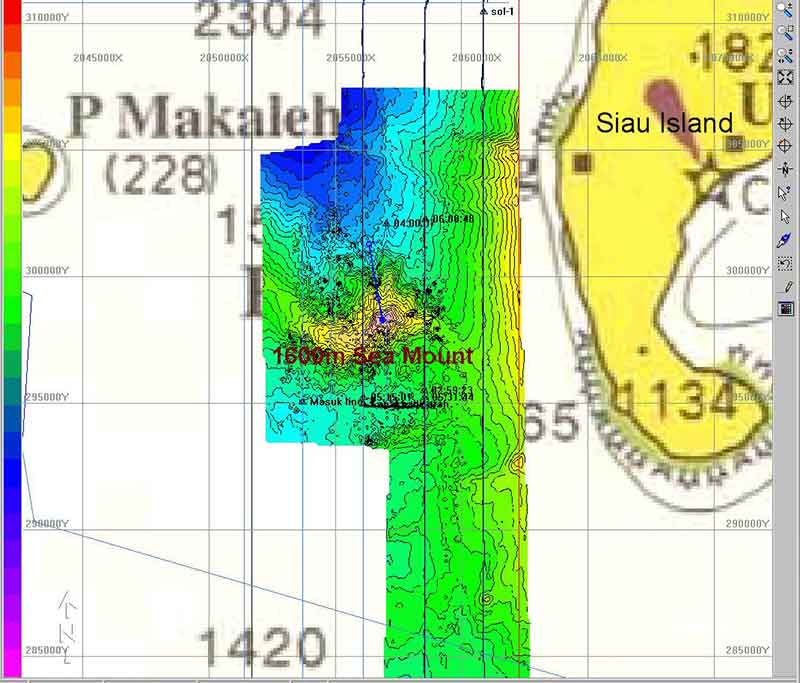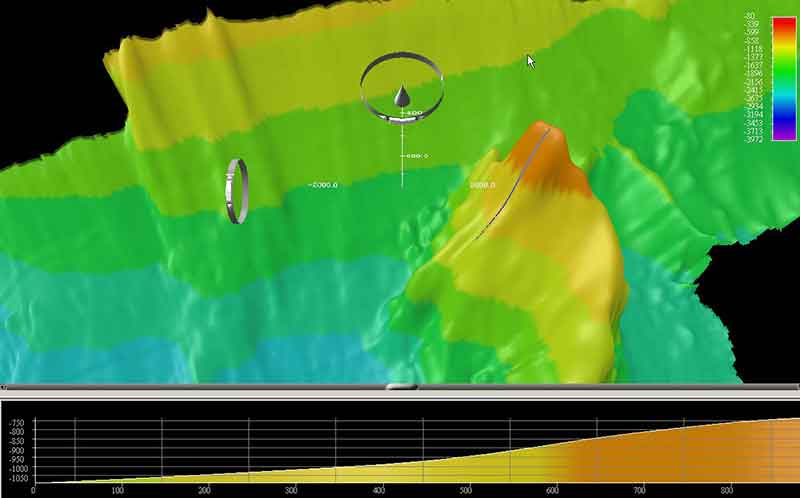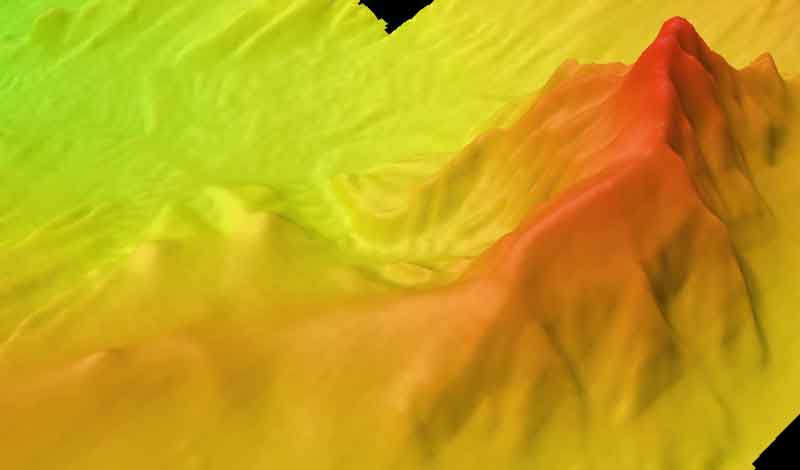
by Wahyu W.Pandoe, Chief Scientist, Indonesian Research Vessel Baruna Jaya IV, BPPT Technology Center for Marine Survey – Indonesia
August 4, 2010

Siau is an active volcano rising 1,827 meters above the ocean and dropping steeply into the sea. The Sangihe Islands are composed of several small islands distributed in a north-south direction. Siau Island is one of them, located 40 nautical miles to the south of the main Sangihe Island. Image courtesy of the NOAA Office of Ocean Exploration and Research, INDEX-SATAL 2010. Download larger version (jpg, 955 KB).
Since last year’s World Ocean Conference (WOC), North Sulawesi (a province of Indonesia) is becoming more popular due to its natural beauty. The hilly landscape and mountainous area reflect a variety of land usse. Offshore to the north of Sulawesi, several islands of varying sizes spread irregularly. The main islands in the region are the Sangihe and Talaud Islands, though they are not widely known by the Indonesian people. The Sulawesi Sea and Pacific Ocean limit these islands to the west and east, respectively. The Philippine mainland is located less than 200 nautical miles to the north. The regional seafloor varies greatly, hosting steep bathymetric areas and depths as deep as 5,000 meters.
>The Sangihe Islands are composed of several small islands distributed in a north-south direction. Siau Island is one of them, located 40 nautical miles to the south of the main Sangihe Island. People are living there peacefully. Siau is an active volcano rising 1,827 meters above the ocean and dropping steeply into the sea.

A new finding of a 1,600-meter-high seamount just 80 kilometers to the west of Siau Island. Image courtesy of the NOAA Office of Ocean Exploration and Research, INDEX-SATAL 2010. Download larger version (jpg, 846 KB).
The Indonesian Research Vessel (R/V) Baruna Jaya IV recently conducted an integrated hydrography, oceanography, geology, and fisheries survey off the west side of this island. Baruna Jaya IV uses a Seabeam 1050 multibeam system to image the seafloor; 126 beams of sound sweep simultaneously across the seafloor from port to starboard sides, measuring the distance to the seafloor. The coverage of the sweep is effectively between 2,500 and 3,000 meters at a time. Continuous measurement while the vessel is moving forward allows a three-dimensional picture of the bathymetry.
Baruna Jaya IV’s recent multibeam survey to the west of Siau revealed a previously unknown seamount rising from seafloor depths of 2,300 meters to 710 meters, or nearly 1,600 meters high. This seamount is located about 8 kilometers to the west of Siau Island. Baruna Jaya IV is further investigating the site by collecting CTD measurements and trawling/dredging to learn more.

Bathymetric image of the new seamount revealed during a hydrographic survey by the Indonesian Research Vessel Baruna Jaya IV. Image courtesy of the NOAA Office of Ocean Exploration and Research, INDEX-SATAL 2010. Download larger version (jpg, 400 KB).
The very steep southern wall of the seamount may cause concern for the people living on the west coast of Siau Island. This area is well known for having frequent earthquakes; a medium magnitude earthquake could potentially cause a submarine landslide that could generate a tsunami wave. While recent mapping efforts have revealed this particular seamount, others likely remain unseen. NOAA Ship Okeanos Explorer has been mapping deeper areas of the Sangihe Talaud region, revealing new underwater features, and will investigate this new seamount with the Little Hercules remotely operated vehicle tomorrow.
This collaborative Indonesia-USA Deep-Sea Exploration of the Sangihe-Talaud Region 2010 (INDEX-SATAL 2010) expedition will provide a more complete picture of the seafloor bathymetry and undersea activity in the Sangihe-Talaud region. The Sangihe-Talaud region is very volcanically active, both above and below the ocean surface. Recent findings of submarine volcanoes have led local people living in the region to wonder about their safety. The data collected during the INDEX-SATAL 2010 expedition will provide a better understanding of the seafloor bathymetry and location of undersea volcanoes. Experts will examine this information and carefully explain the advantages and disadvantages of living in an area surrounded by volcanoes to the local people. We hope the information collected during this expedition will help the local people to live in a safe and peaceful environment!

Bathymetric image of the new seamount discovered by Baruna Jaya IV, represented with multibeam data collected by NOAA Ship Okeanos Explorer. NOAA plans to conduct two dives using the Little Hercules remotely operated vehicle on this seamount to further explore what is there. Image courtesy of the NOAA Office of Ocean Exploration and Research, INDEX-SATAL 2010. Download larger version (jpg, 158 KB).